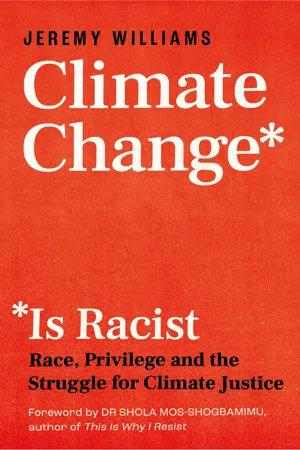
Climate Change Is Racist
Race, Privilege and the Struggle for Climate Justice
- 128 pages
- English
- ePUB (mobile friendly)
- Available on iOS & Android
About this book
** LONGLISTED FOR THE JAMES CROPPER WAINWRIGHT PRIZE LONGLIST 2022 **
'Really packs a punch' Aja Barber, author of
Consumed: The Need for Collective Change: Colonialism, Climate Change, and Consumerism
'Will open the minds of even the most ardent denier of climate change and/or systemic racism. If there's one book that will help you to be an effective activist for climate justice, it's this one.' Dr Shola Mos-Shogbamimu, author of
This is Why I Resist
'Accessible. Poignant. Challenging.' Nnimmo Bassey, environmentalist and author of
To Cook a Continent: Destructive Extraction and the Climate Crisis in Africa
When we talk about racism, we often mean personal prejudice or institutional biases. Climate change doesn't work that way. It is structurally racist, disproportionately caused by majority White people in majority White countries, with the damage unleashed overwhelmingly on people of colour. The climate crisis reflects and reinforces racial injustices.
In this eye-opening book, writer and environmental activist Jeremy Williams takes us on a short, urgent journey across the globe - from Kenya to India, the USA to Australia - to understand how White privilege and climate change overlap. We'll look at the environmental facts, hear the experiences of the people most affected on our planet and learn from the activists leading the change.
It's time for each of us to find our place in the global struggle for justice.
Frequently asked questions
- Essential is ideal for learners and professionals who enjoy exploring a wide range of subjects. Access the Essential Library with 800,000+ trusted titles and best-sellers across business, personal growth, and the humanities. Includes unlimited reading time and Standard Read Aloud voice.
- Complete: Perfect for advanced learners and researchers needing full, unrestricted access. Unlock 1.4M+ books across hundreds of subjects, including academic and specialized titles. The Complete Plan also includes advanced features like Premium Read Aloud and Research Assistant.
Please note we cannot support devices running on iOS 13 and Android 7 or earlier. Learn more about using the app.
Information
Who causes climate change?
Who are we?
- Canada – 14,612 kwh
- Kuwait – 14,090 kwh
- United States – 12,154 kwh
- Australia – 9,502 kwh
- Saudi Arabia – 9,407 kwh
- Japan – 7,150 kwh
- Germany – 6,306 kwh
- China – 4,617 kwh
- Britain – 4,496 kwh
- Madagascar – 78 kwh
Unequal carbon footprints
Historic responsibility

Table of contents
- Title Page
- Dedication
- Contents
- Foreword by Dr Shola Mos-Shogbamimu
- Preface
- Introduction
- 1: Who causes climate change?
- 2: Who suffers climate change?
- 3: Environmental justice
- 4: Climate change at the intersection
- 5: The deep roots of climate injustice
- 6: Climate violence
- 7: Climate privilege
- 8: The empathy gap
- 9: Representation
- 10: Doing justice
- 11: Common cause
- 12: Living with the questions
- Acknowledgements
- About the Author
- Copyright